warning light SKODA OCTAVIA 2012 3.G / (5E) Manual Online
[x] Cancel search | Manufacturer: SKODA, Model Year: 2012, Model line: OCTAVIA, Model: SKODA OCTAVIA 2012 3.G / (5E)Pages: 222, PDF Size: 13.52 MB
Page 154 of 222
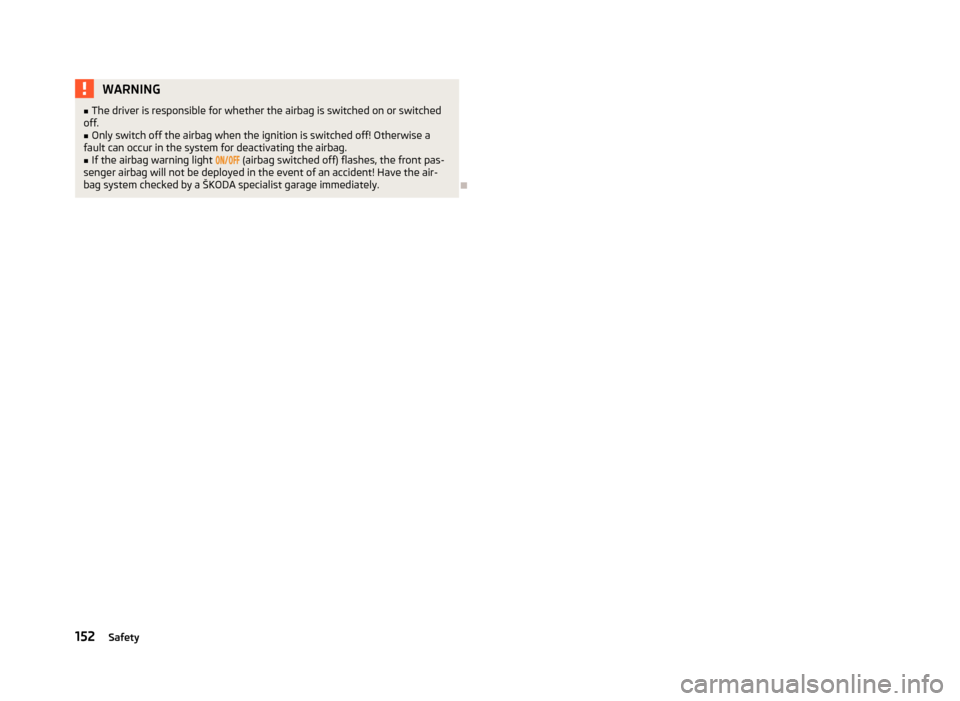
WARNING■The driver is responsible for whether the airbag is switched on or switched
off.■
Only switch off the airbag when the ignition is switched off! Otherwise a
fault can occur in the system for deactivating the airbag.
■
If the airbag warning light (airbag switched off) flashes, the front pas-
senger airbag will not be deployed in the event of an accident! Have the air-
bag system checked by a ŠKODA specialist garage immediately.
152Safety
Page 155 of 222
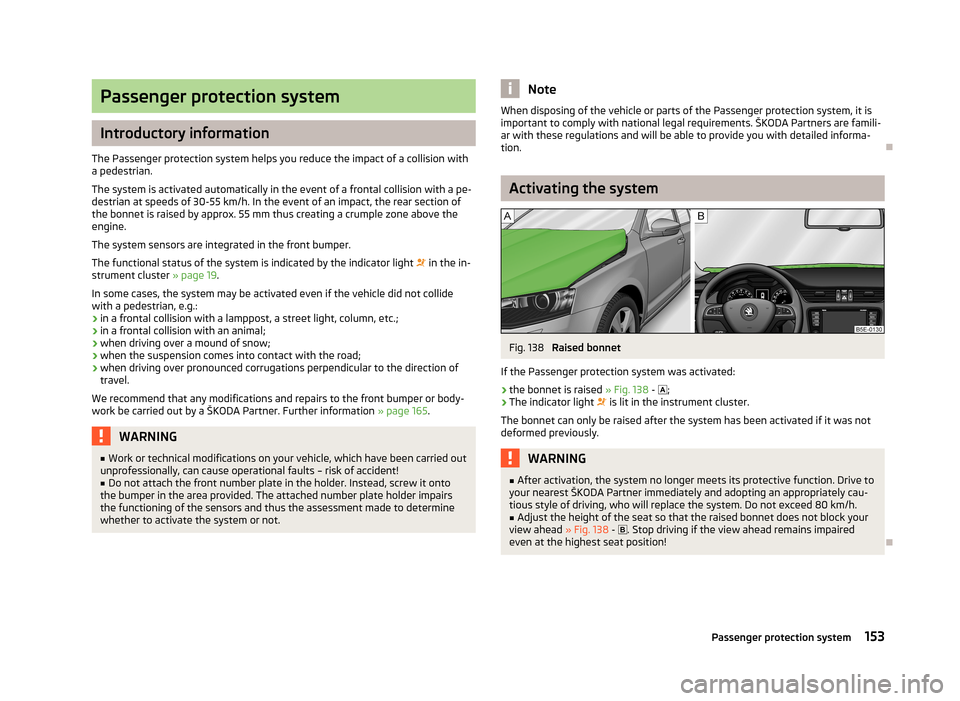
Passenger protection system
Introductory information
The Passenger protection system helps you reduce the impact of a collision with a pedestrian.
The system is activated automatically in the event of a frontal collision with a pe-
destrian at speeds of 30-55 km/h. In the event of an impact, the rear section of
the bonnet is raised by approx. 55 mm thus creating a crumple zone above the
engine.
The system sensors are integrated in the front bumper.
The functional status of the system is indicated by the indicator light
in the in-
strument cluster » page 19.
In some cases, the system may be activated even if the vehicle did not collide
with a pedestrian, e.g.:
› in a frontal collision with a lamppost, a street light, column, etc.;
› in a frontal collision with an animal;
› when driving over a mound of snow;
› when the suspension comes into contact with the road;
› when driving over pronounced corrugations perpendicular to the direction of
travel.
We recommend that any modifications and repairs to the front bumper or body-
work be carried out by a ŠKODA Partner. Further information » page 165.
WARNING■
Work or technical modifications on your vehicle, which have been carried out
unprofessionally, can cause operational faults – risk of accident!■
Do not attach the front number plate in the holder. Instead, screw it onto
the bumper in the area provided. The attached number plate holder impairs
the functioning of the sensors and thus the assessment made to determine
whether to activate the system or not.
NoteWhen disposing of the vehicle or parts of the Passenger protection system, it is
important to comply with national legal requirements. ŠKODA Partners are famili-
ar with these regulations and will be able to provide you with detailed informa-
tion.
Activating the system
Fig. 138
Raised bonnet
If the Passenger protection system was activated:
› the bonnet is raised
» Fig. 138 -
;
› The indicator light
is lit in the instrument cluster.
The bonnet can only be raised after the system has been activated if it was not deformed previously.
WARNING■ After activation, the system no longer meets its protective function. Drive to
your nearest ŠKODA Partner immediately and adopting an appropriately cau-
tious style of driving, who will replace the system. Do not exceed 80 km/h.■
Adjust the height of the seat so that the raised bonnet does not block your
view ahead » Fig. 138 - . Stop driving if the view ahead remains impaired
even at the highest seat position!
153Passenger protection system
Page 161 of 222
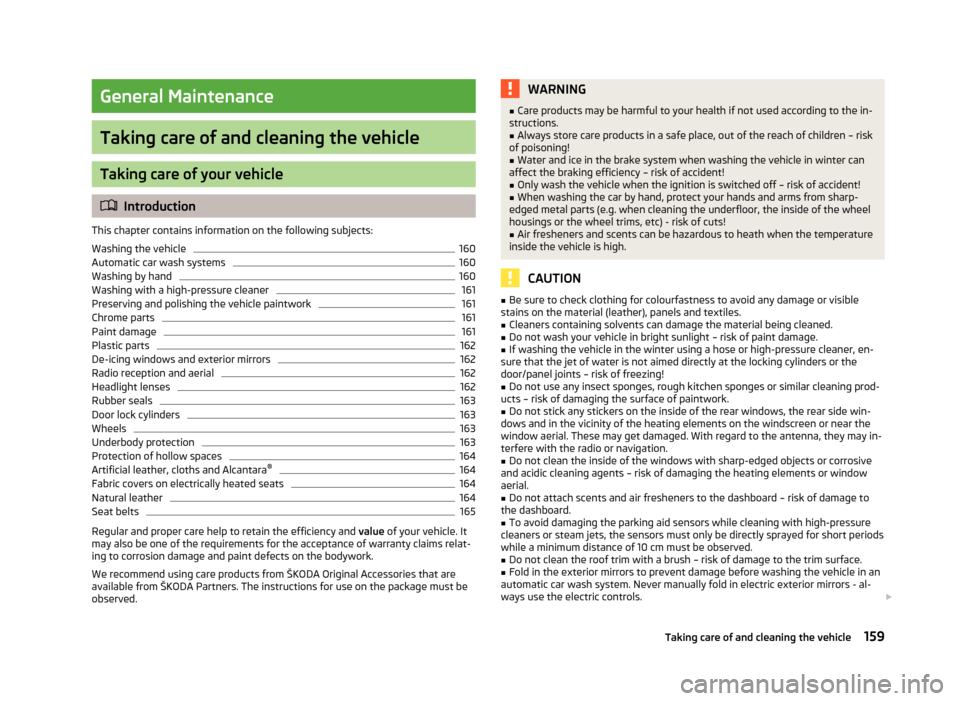
General Maintenance
Taking care of and cleaning the vehicle
Taking care of your vehicle
Introduction
This chapter contains information on the following subjects:
Washing the vehicle
160
Automatic car wash systems
160
Washing by hand
160
Washing with a high-pressure cleaner
161
Preserving and polishing the vehicle paintwork
161
Chrome parts
161
Paint damage
161
Plastic parts
162
De-icing windows and exterior mirrors
162
Radio reception and aerial
162
Headlight lenses
162
Rubber seals
163
Door lock cylinders
163
Wheels
163
Underbody protection
163
Protection of hollow spaces
164
Artificial leather, cloths and Alcantara ®
164
Fabric covers on electrically heated seats
164
Natural leather
164
Seat belts
165
Regular and proper care help to retain the efficiency and
value of your vehicle. It
may also be one of the requirements for the acceptance of warranty claims relat- ing to corrosion damage and paint defects on the bodywork.
We recommend using care products from ŠKODA Original Accessories that areavailable from ŠKODA Partners. The instructions for use on the package must be
observed.
WARNING■ Care products may be harmful to your health if not used according to the in-
structions.■
Always store care products in a safe place, out of the reach of children – risk
of poisoning!
■
Water and ice in the brake system when washing the vehicle in winter can
affect the braking efficiency – risk of accident!
■
Only wash the vehicle when the ignition is switched off – risk of accident!
■
When washing the car by hand, protect your hands and arms from sharp-
edged metal parts (e.g. when cleaning the underfloor, the inside of the wheel
housings or the wheel trims, etc) - risk of cuts!
■
Air fresheners and scents can be hazardous to heath when the temperature
inside the vehicle is high.
CAUTION
■ Be sure to check clothing for colourfastness to avoid any damage or visible
stains on the material (leather), panels and textiles.■
Cleaners containing solvents can damage the material being cleaned.
■
Do not wash your vehicle in bright sunlight – risk of paint damage.
■
If washing the vehicle in the winter using a hose or high-pressure cleaner, en-
sure that the jet of water is not aimed directly at the locking cylinders or the
door/panel joints – risk of freezing!
■
Do not use any insect sponges, rough kitchen sponges or similar cleaning prod-
ucts – risk of damaging the surface of paintwork.
■
Do not stick any stickers on the inside of the rear windows, the rear side win-
dows and in the vicinity of the heating elements on the windscreen or near the
window aerial. These may get damaged. With regard to the antenna, they may in-terfere with the radio or navigation.
■
Do not clean the inside of the windows with sharp-edged objects or corrosive
and acidic cleaning agents – risk of damaging the heating elements or window
aerial.
■
Do not attach scents and air fresheners to the dashboard – risk of damage to
the dashboard.
■
To avoid damaging the parking aid sensors while cleaning with high-pressure
cleaners or steam jets, the sensors must only be directly sprayed for short periods while a minimum distance of 10 cm must be observed.
■
Do not clean the roof trim with a brush – risk of damage to the trim surface.
■
Fold in the exterior mirrors to prevent damage before washing the vehicle in an
automatic car wash system. Never manually fold in electric exterior mirrors - al-
ways use the electric controls.
159Taking care of and cleaning the vehicle
Page 163 of 222

Washing with a high-pressure cleanerFirst read and observe the introductory information and safety warn-
ings
on page 159.
When washing the vehicle with a high-pressure cleaner, the instructions for use
of the equipment must be observed. This applies in particular to the pressure
used and to the spraying distance . Maintain a sufficiently large distance to the
parking aid sensors and soft materials such as rubber hoses or insulation materi- al.
WARNINGNever use circular spray nozzles or dirt cutters!
CAUTION
The temperature of the water used for cleaning must not exceed 60 °C – risk of damaging the vehicle.
Preserving and polishing the vehicle paintwork
First read and observe the introductory information and safety warn-
ings
on page 159.
Preserving the vehicle paintwork
Thorough wax treatment is an effective way of protecting the paintwork from harmful environmental influences.
The vehicle must be treated with a high-quality hard wax polish at the latest, when no more drops form on the clean paintwork.
A new layer of a high-quality hard wax polish can be applied to the clean body- work after it has dried thoroughly. Even if you use a wax preserver regularly we
still recommend that you treat the paintwork of the vehicle at least twice a year
with hard wax.
Polishing
Polishing is necessary if the vehicle's paintwork has become unattractive and if it
is no longer possible to achieve a gloss with wax preservatives.
If the polish does not contain any preserving elements, the paint must be treated with a preservative afterwards.
CAUTION■ Never apply wax to the windows.■Mat painted or plastic parts must not be treated with polishing products or hard
waxes.■
Do not polish the paintwork of the vehicle in a dusty environment, otherwise
the paintwork can be scratched.
Chrome parts
First read and observe the introductory information and safety warn-ings
on page 159.
First clean the chrome parts with a damp cloth and then polish them with a soft,
dry cloth. If this method does not completely clean chrome parts, use a specific
chrome care product.
CAUTION
Do not polish the chrome parts in a dusty environment, otherwise they can be
scratched.
Paint damage
First read and observe the introductory information and safety warn-
ings
on page 159.
Slight damage to paintwork such as scratches, scuffs or traces of chip damage
must be treated immediately.
The ŠKODA Partners have a range of matching touch-up pens or spray cans avail-
able in the colour of your vehicle.
Note
We recommend that any repairs to damaged paintwork are carried out by a
ŠKODA Partner.
161Taking care of and cleaning the vehicle
Page 165 of 222

Rubber sealsFirst read and observe the introductory information and safety warn-
ings
on page 159.
The rubber seals on doors, door panels, and the sliding roof remain smoother and
last longer if the seals are treated regularly with a suitable rubber care product.
This helps to prevent leakages and premature wear of the seals. Rubber seals
which are well cared for also do not stick together in cold winter weather.
Door lock cylinders
First read and observe the introductory information and safety warn-
ings
on page 159.
Specific products must be used for de-icing door lock cylinders.
When washing your vehicle, ensure as little water as possible gets into the lock- ing cylinders.
Note
We recommend that suitable materials from ŠKODA Original Accessories are used for maintaining the door lock cylinders.
Wheels
First read and observe the introductory information and safety warn-
ings
on page 159.
Wheel rims
Also thoroughly wash the wheel rims when washing the vehicle on a regular ba- sis. Regularly remove salt and brake abrasion from the wheel rims otherwise the material will be affected. Damage to the paint layer on the wheel rims must be
touched up immediately.
Light alloy wheels
After washing thoroughly and treat the wheel rims with a protective product for
light alloy wheels. Products which cause abrasion must not be used to treat the
wheel rims.
WARNINGWater, ice and grit in the brake system can affect the braking efficiency – risk
of accident!
CAUTION
Severe layers of dirt on the wheels can also result in wheel imbalance. This may
show itself in the form of a wheel vibration which is transmitted to the steering
wheel which, in certain circumstances, can cause premature wear of the steering.
This means it is necessary to remove the dirt.
Note
We recommend that any repairs to damaged paintwork are carried out by a
ŠKODA Partner.
Underbody protection
First read and observe the introductory information and safety warn-ings
on page 159.
The underside of your vehicle is protected for life against chemical and mechani-
cal influences.
As damage to the protective layer when driving cannot be ruled out completely,
we recommend that you inspect the protective layer on the underside of your ve- hicle and on the chassis at specific intervals – preferably at the beginning and end
of the winter.
ŠKODA Partners have suitable spray products and the necessary equipment
available, and are familiar with the instructions for use. We therefore recommend
that touch-up work or additional corrosion protection measures are carried out by
a ŠKODA Partner.
WARNINGNever use additional underbody protection or anti-corrosion agents for ex-
haust pipes, catalytic converters, diesel particle filters or heat shields. When
the engine reaches its operating temperature, these substances might ignite
– risk of fire!
163Taking care of and cleaning the vehicle
Page 166 of 222
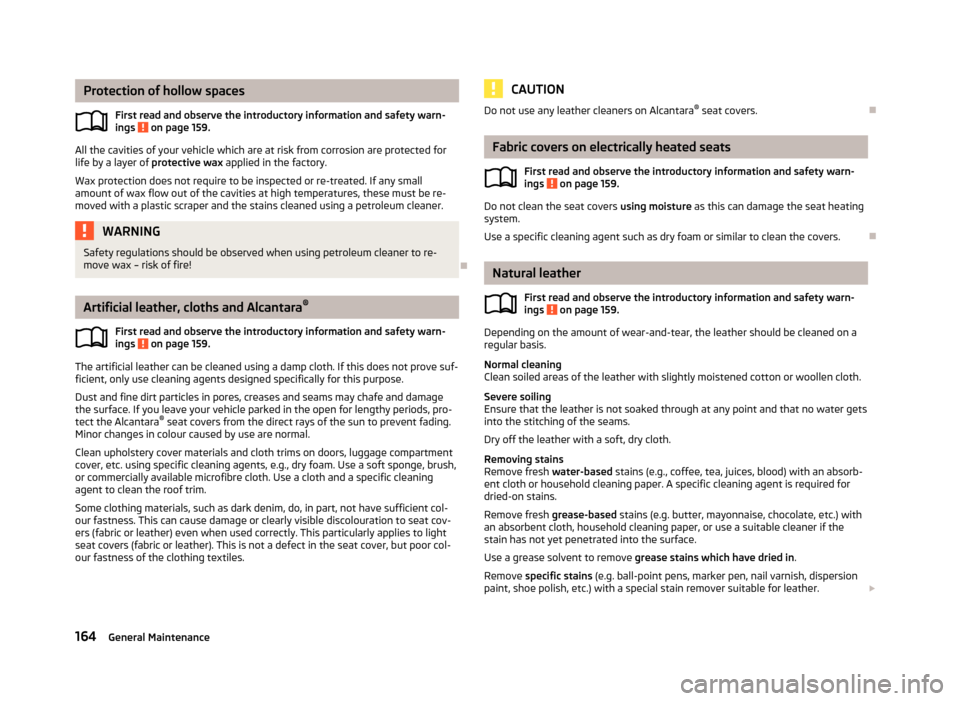
Protection of hollow spacesFirst read and observe the introductory information and safety warn-
ings
on page 159.
All the cavities of your vehicle which are at risk from corrosion are protected for life by a layer of protective wax applied in the factory.
Wax protection does not require to be inspected or re-treated. If any small amount of wax flow out of the cavities at high temperatures, these must be re-
moved with a plastic scraper and the stains cleaned using a petroleum cleaner.
WARNINGSafety regulations should be observed when using petroleum cleaner to re-
move wax – risk of fire!
Artificial leather, cloths and Alcantara ®
First read and observe the introductory information and safety warn- ings
on page 159.
The artificial leather can be cleaned using a damp cloth. If this does not prove suf-
ficient, only use cleaning agents designed specifically for this purpose.
Dust and fine dirt particles in pores, creases and seams may chafe and damagethe surface. If you leave your vehicle parked in the open for lengthy periods, pro-
tect the Alcantara ®
seat covers from the direct rays of the sun to prevent fading.
Minor changes in colour caused by use are normal.
Clean upholstery cover materials and cloth trims on doors, luggage compartment
cover, etc. using specific cleaning agents, e.g., dry foam. Use a soft sponge, brush,
or commercially available microfibre cloth. Use a cloth and a specific cleaning
agent to clean the roof trim.
Some clothing materials, such as dark denim, do, in part, not have sufficient col-
our fastness. This can cause damage or clearly visible discolouration to seat cov-
ers (fabric or leather) even when used correctly. This particularly applies to light
seat covers (fabric or leather). This is not a defect in the seat cover, but poor col-
our fastness of the clothing textiles.
CAUTIONDo not use any leather cleaners on Alcantara ®
seat covers.
Fabric covers on electrically heated seats
First read and observe the introductory information and safety warn-
ings
on page 159.
Do not clean the seat covers using moisture as this can damage the seat heating
system.
Use a specific cleaning agent such as dry foam or similar to clean the covers.
Natural leather
First read and observe the introductory information and safety warn-
ings
on page 159.
Depending on the amount of wear-and-tear, the leather should be cleaned on a
regular basis.
Normal cleaning
Clean soiled areas of the leather with slightly moistened cotton or woollen cloth.
Severe soiling
Ensure that the leather is not soaked through at any point and that no water gets
into the stitching of the seams.
Dry off the leather with a soft, dry cloth.
Removing stains
Remove fresh water-based stains (e.g., coffee, tea, juices, blood) with an absorb-
ent cloth or household cleaning paper. A specific cleaning agent is required for
dried-on stains.
Remove fresh grease-based stains (e.g. butter, mayonnaise, chocolate, etc.) with
an absorbent cloth, household cleaning paper, or use a suitable cleaner if the
stain has not yet penetrated into the surface.
Use a grease solvent to remove grease stains which have dried in .
Remove specific stains (e.g. ball-point pens, marker pen, nail varnish, dispersion
paint, shoe polish, etc.) with a special stain remover suitable for leather.
164General Maintenance
Page 167 of 222
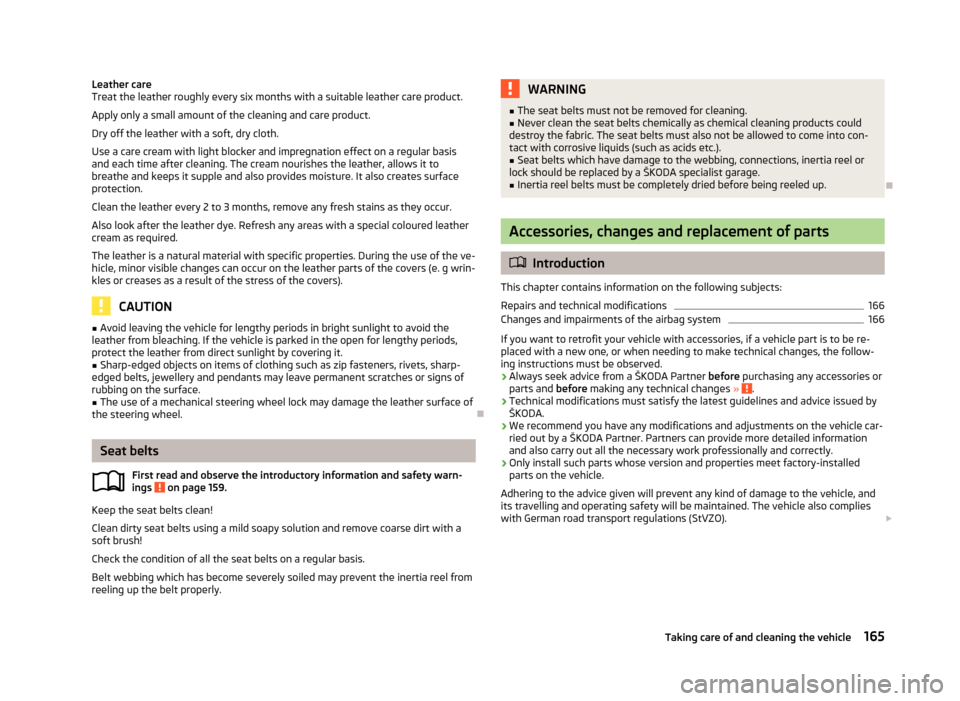
Leather care
Treat the leather roughly every six months with a suitable leather care product.
Apply only a small amount of the cleaning and care product.
Dry off the leather with a soft, dry cloth.
Use a care cream with light blocker and impregnation effect on a regular basis and each time after cleaning. The cream nourishes the leather, allows it to
breathe and keeps it supple and also provides moisture. It also creates surface
protection.
Clean the leather every 2 to 3 months, remove any fresh stains as they occur. Also look after the leather dye. Refresh any areas with a special coloured leather cream as required.
The leather is a natural material with specific properties. During the use of the ve- hicle, minor visible changes can occur on the leather parts of the covers (e. g wrin- kles or creases as a result of the stress of the covers).
CAUTION
■ Avoid leaving the vehicle for lengthy periods in bright sunlight to avoid the
leather from bleaching. If the vehicle is parked in the open for lengthy periods,
protect the leather from direct sunlight by covering it.■
Sharp-edged objects on items of clothing such as zip fasteners, rivets, sharp-
edged belts, jewellery and pendants may leave permanent scratches or signs of
rubbing on the surface.
■
The use of a mechanical steering wheel lock may damage the leather surface of
the steering wheel.
Seat belts
First read and observe the introductory information and safety warn-
ings
on page 159.
Keep the seat belts clean!
Clean dirty seat belts using a mild soapy solution and remove coarse dirt with a soft brush!
Check the condition of all the seat belts on a regular basis. Belt webbing which has become severely soiled may prevent the inertia reel from
reeling up the belt properly.
WARNING■ The seat belts must not be removed for cleaning.■Never clean the seat belts chemically as chemical cleaning products could
destroy the fabric. The seat belts must also not be allowed to come into con-
tact with corrosive liquids (such as acids etc.).■
Seat belts which have damage to the webbing, connections, inertia reel or
lock should be replaced by a ŠKODA specialist garage.
■
Inertia reel belts must be completely dried before being reeled up.
Accessories, changes and replacement of parts
Introduction
This chapter contains information on the following subjects:
Repairs and technical modifications
166
Changes and impairments of the airbag system
166
If you want to retrofit your vehicle with accessories, if a vehicle part is to be re-
placed with a new one, or when needing to make technical changes, the follow-
ing instructions must be observed.
› Always seek advice from a ŠKODA Partner
before purchasing any accessories or
parts and before making any technical changes »
.
› Technical modifications must satisfy the latest guidelines and advice issued by
ŠKODA.
› We recommend you have any modifications and adjustments on the vehicle car-
ried out by a ŠKODA Partner. Partners can provide more detailed information
and also carry out all the necessary work professionally and correctly.
› Only install such parts whose version and properties meet factory-installed
parts on the vehicle.
Adhering to the advice given will prevent any kind of damage to the vehicle, and
its travelling and operating safety will be maintained. The vehicle also complies
with German road transport regulations (StVZO).
165Taking care of and cleaning the vehicle
Page 175 of 222
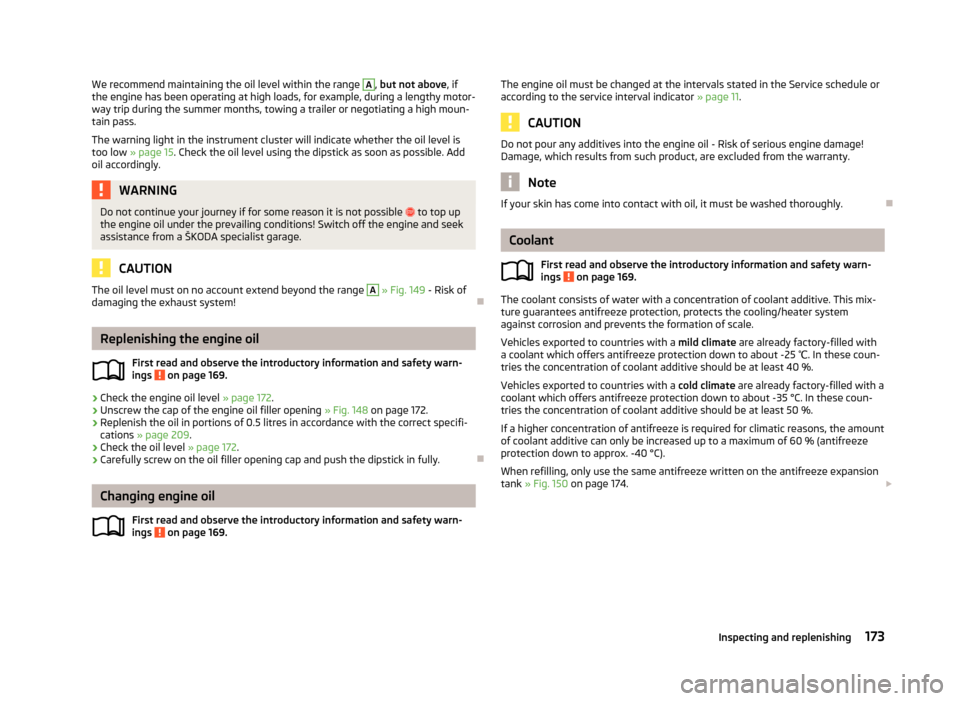
We recommend maintaining the oil level within the range A, but not above , if
the engine has been operating at high loads, for example, during a lengthy motor-
way trip during the summer months, towing a trailer or negotiating a high moun- tain pass.
The warning light in the instrument cluster will indicate whether the oil level is too low » page 15 . Check the oil level using the dipstick as soon as possible. Add
oil accordingly.WARNINGDo not continue your journey if for some reason it is not possible to top up
the engine oil under the prevailing conditions! Switch off the engine and seek
assistance from a ŠKODA specialist garage.
CAUTION
The oil level must on no account extend beyond the range A » Fig. 149 - Risk of
damaging the exhaust system!
Replenishing the engine oil
First read and observe the introductory information and safety warn-
ings
on page 169.
›
Check the engine oil level » page 172.
›
Unscrew the cap of the engine oil filler opening » Fig. 148 on page 172.
›
Replenish the oil in portions of 0.5 litres in accordance with the correct specifi-
cations » page 209 .
›
Check the oil level » page 172.
›
Carefully screw on the oil filler opening cap and push the dipstick in fully.
Changing engine oil
First read and observe the introductory information and safety warn-
ings
on page 169.
The engine oil must be changed at the intervals stated in the Service schedule or
according to the service interval indicator » page 11.
CAUTION
Do not pour any additives into the engine oil - Risk of serious engine damage!
Damage, which results from such product, are excluded from the warranty.
Note
If your skin has come into contact with oil, it must be washed thoroughly.
Coolant
First read and observe the introductory information and safety warn-ings
on page 169.
The coolant consists of water with a concentration of coolant additive. This mix-
ture guarantees antifreeze protection, protects the cooling/heater system
against corrosion and prevents the formation of scale.
Vehicles exported to countries with a mild climate are already factory-filled with
a coolant which offers antifreeze protection down to about -25 ℃. In these coun-
tries the concentration of coolant additive should be at least 40 %.
Vehicles exported to countries with a cold climate are already factory-filled with a
coolant which offers antifreeze protection down to about -35 °C. In these coun-
tries the concentration of coolant additive should be at least 50 %.
If a higher concentration of antifreeze is required for climatic reasons, the amount
of coolant additive can only be increased up to a maximum of 60 % (antifreeze
protection down to approx. -40 °C).
When refilling, only use the same antifreeze written on the antifreeze expansion tank » Fig. 150 on page 174.
173Inspecting and replenishing
Page 176 of 222

Coolant capacity1)Petrol enginesCapacities (in litres)1.2 ltr./63 kW TSI8.91.4 ltr./103 kW TSI10.21.8 ltr./132 kW TSI7.8Diesel enginesCapacities (in litres)1.6 ltr./77 kW TDI CR8.42.0 l/110 kW TDI CR - MG/DSG11,6 / 11,9
CAUTION
■
The amount of coolant additive in the coolant must never be allowed to be less
than 40 %.■
Over 60 % of coolant additive in the coolant reduces the antifreeze protection
and coolant effectiveness.
■
Other coolant additives that do not comply with the correct specifications can
above all significantly reduce the anticorrosion effect.
■
Any faults resulting from corrosion may cause a loss of coolant and can conse-
quently result in major engine damage!
Checking the coolant level
Fig. 150
Engine compartment: Coolant
expansion reservoir
First read and observe the introductory information and safety warn-
ings on page 169.
The coolant expansion bottle is located in the engine compartment.
Inspecting the coolant level›
Switch off the engine.
›
Open the bonnet.
›
Check the level of coolant in the coolant expansion bottle » Fig. 150.
Coolant level within range
A
The level may also rise slightly above the
A
marking when the engine is warm.
›
No coolant must be refilled.
Coolant level within range
A
and
B
When the engine is cold, the coolant level must lie between the
A
and
B
mark-
ings.
›
Coolant can be refilled.
Coolant level within range under
B›
Coolant must be refilled.
When the engine is cold, refill the coolant between the markings
A
and
B
.
If the coolant level in the expansion tank is too low, this will be signalised by the warning light
illuminating in the instrument cluster » page 15, Coolant temper-
ature/coolant level
, however we recommend you regularly check the coolant
level in the container directly.
Loss of coolant
A loss of coolant is first and foremost an indication of a leak in the system. Do
not merely top up the coolant. Have the cooling system checked by a ŠKODA spe- cialist garage.
WARNING Do not continue your journey, if for some reason it is not possible to top up
the coolant under the prevailing conditions! Switch off the engine and seek
assistance from a ŠKODA specialist garage. 1)
On vehicles that are fitted with an auxiliary heater (auxiliary heating and ventilation), the coolant ca-
pacity is approx. 1 l larger.
174General Maintenance
Page 177 of 222
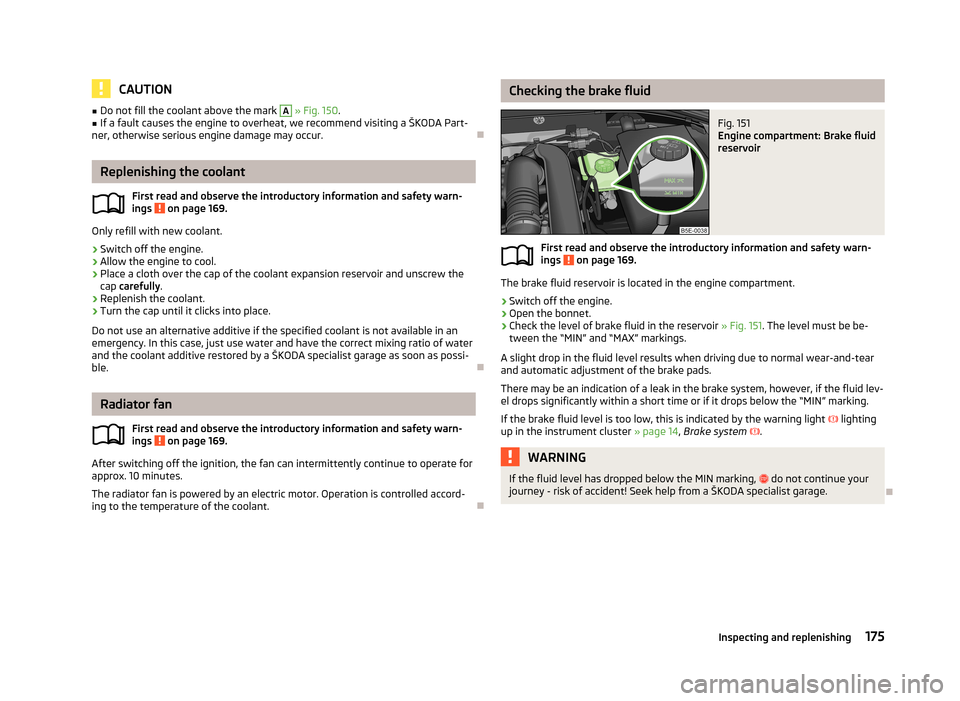
CAUTION■Do not fill the coolant above the mark A » Fig. 150 .■If a fault causes the engine to overheat, we recommend visiting a ŠKODA Part-
ner, otherwise serious engine damage may occur.
Replenishing the coolant
First read and observe the introductory information and safety warn-ings
on page 169.
Only refill with new coolant.
›
Switch off the engine.
›
Allow the engine to cool.
›
Place a cloth over the cap of the coolant expansion reservoir and unscrew the
cap carefully .
›
Replenish the coolant.
›
Turn the cap until it clicks into place.
Do not use an alternative additive if the specified coolant is not available in an emergency. In this case, just use water and have the correct mixing ratio of water
and the coolant additive restored by a ŠKODA specialist garage as soon as possi-
ble.
Radiator fan
First read and observe the introductory information and safety warn-
ings
on page 169.
After switching off the ignition, the fan can intermittently continue to operate for
approx. 10 minutes.
The radiator fan is powered by an electric motor. Operation is controlled accord-
ing to the temperature of the coolant.
Checking the brake fluidFig. 151
Engine compartment: Brake fluid
reservoir
First read and observe the introductory information and safety warn-
ings on page 169.
The brake fluid reservoir is located in the engine compartment.
›
Switch off the engine.
›
Open the bonnet.
›
Check the level of brake fluid in the reservoir » Fig. 151. The level must be be-
tween the “MIN” and “MAX” markings.
A slight drop in the fluid level results when driving due to normal wear-and-tear and automatic adjustment of the brake pads.
There may be an indication of a leak in the brake system, however, if the fluid lev-
el drops significantly within a short time or if it drops below the “MIN” marking.
If the brake fluid level is too low, this is indicated by the warning light
lighting
up in the instrument cluster » page 14, Brake system
.
WARNINGIf the fluid level has dropped below the MIN marking, do not continue your
journey - risk of accident! Seek help from a ŠKODA specialist garage.
175Inspecting and replenishing